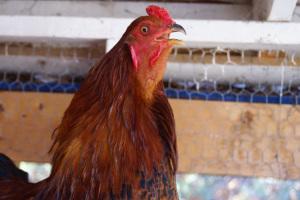We’ve had to harvest a total of 3 roosters this winter. All from the eggs that we had incubated during the summer and while we had our suspicions, we waited until the last minute (or the neighbors complained) before we took action.
Baby chickens all look alike (except of course for sex-linked birds) you really can’t tell if a bird is male or female until they get older.
Oh, for sure, there are some clues along the way. For example, for the most part males have bigger, thicker, legs and feet than the hens do.
Here is a rooster’s feet:

And here is a lovely lady checking out those feet.

Although roosters will have a larger comb than the ladies, hens can and do develop impressive combs, so – at least initially – the presence of a comb is not a reliable way to tell if you have a bad boy in your flock.
Same thing with aggression, the males tend to be more aggressive than the females, but don’t tell that to Zelda who will challenge even the tallest giant who steps foot into the coop.
Roosters have tails. Males develop that beautiful plumage for which they are well known. But then there are some hens out there sporting impressive butt bling (in fact our Black Copper Maran chick; Charlie has enough tail feathers that she made me initially fear she was a rooster.)
Are you starting to see why it’s so difficult to detect a rooster? You don’t want to cull a bird if there is even a remote chance that he could actually be a she.
So what do you do?
You wait for this:

The cock crowing.
And you wait for the inevitable knock on the door from your neighbors asking you if there is anything you can do about the noise.
Then you know.

